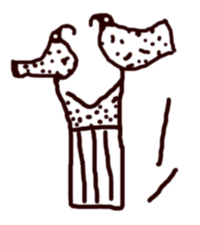Double Falcon facts for kids
Quick facts for kids Double Falcon |
|
|---|---|
| Dju?, Nebwy? | |

Serekh of Double Falcon. Redrawing of an inscription on a vessel found in el-Beda.
|
|
| Pharaoh | |
| Reign | c. 3220 BC (Naqada III) |
| Predecessor | Unknown |
Double Falcon (also called Dju or Nebwy) was an early pharaoh of Lower Egypt. He ruled during a time known as the Predynastic period, before the famous dynasties began. We don't know exactly when he ruled, but it was probably around 3220 BC. The length of his reign is also unknown.
Discovering King Double Falcon
In 1910, an expert on ancient Egypt named M. J. Clédat found the first clues about King Double Falcon. A farmer in el-Mehemdiah, in the north-eastern delta, brought him a jar and some carved pieces. These items were found while the farmer was planting a palm-grove nearby. Clédat soon found four serekhs (special symbols showing a king's name) belonging to King Double Falcon.
Later, in 1912, another expert named Hermann Junker found a tomb in Tura. Inside, there was a complete jar with a serekh on it. This serekh also had two falcons on top.
More serekhs of King Double Falcon have been found in different places. These include the Sinai, Tell Ibrahim Awad in the eastern delta, and Adaima and Abydos in Upper Egypt. A serekh was even found in the Palmahim quarry in southern Israel.
Because most of these finds are in Lower Egypt and the north-western Sinai, it suggests that Double Falcon mainly ruled over these areas. However, finding some of his serekhs in Upper Egypt and Canaan (modern-day Israel) shows something important. It means that the power of these early kings was starting to spread. This expansion likely happened through trading or even through battles towards the end of the Naqada III period.
What His Name Means
The serekh of Double Falcon is very special and different from others. First, it's the only one that has two Horus falcons on top. These falcons face each other. Second, the serekh doesn't have a clear space for the king's name. Instead, this area is filled with vertical lines. These lines usually show the fancy front of a palace.
Also, this serekh doesn't have the usual horizontal line. This line normally separates the palace design from the ruler's name above it. Finally, each falcon stands on its own peak, like a mountain.
Experts believe these unique features have special meanings. The two falcons might represent Lower Egypt and the Sinai. This makes sense because it seems Double Falcon ruled over both regions. One expert, Dreyer, thinks the falcons stand on a sign that means "mountain." He reads the king's name as Dju.
Another expert, van den Brink, reads the name as Nebwy. This means "the two lords." This name is similar to a much older cosmetic palette that is now in a museum in Geneva.
See also
 In Spanish: Doble Halcón para niños
In Spanish: Doble Halcón para niños

